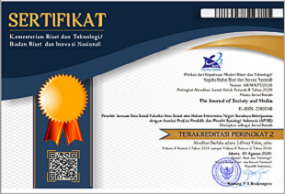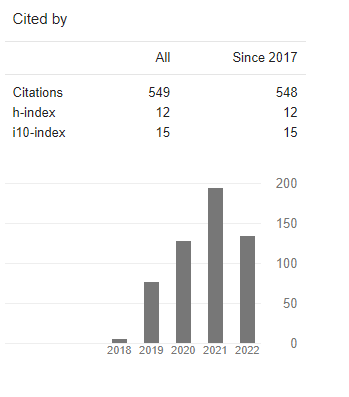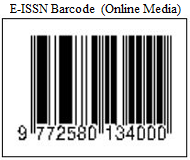Pemanfaatan Aplikasi Telegram sebagai Media Komunikasi dan Informasi Tim penjualan & pemasaran CV Ardent Furnitur
DOI:
https://doi.org/10.26740/jsm.v9n2.p438-478Kata Kunci:
Communication Media, Telegram, Online Communication, Organisational CommunicationAbstrak
Media Komunikasi digunakan sebagai sarana produksi, distribusi dan menyebarkan informasi. Media Komunikasi berperan sebagai hal yang utama dalam proses interaksi antar invidu dalam kehidupan sosial dan berkepentingan. Salah satu bentuk media komunikasi yang sering digunakan di era saat ini dalam komunikasi antar individu dan kelompok adalah media digital. Beberapa bentuk media digital yang sering digunakan dalam proses komunikasi yaitu Whatsaap, email, online meeting room dan telegram. Kemudahan dalam penggunaan media digital dan beragamnya fitur yang ditawarkan di dalamnya menjadi salah satu kelebihan yang bermanfaat untuk mendukung kebutuhan komunikasi dan sarana bertukar informasi yang diterapkan pada Tim penjualan & pemasarandi CV Ardent Furniture. Aplikasi Telegram merupakan salah satu aplikasi berbasis online yang intesitas penggunaannya cukup tinggi dalam komunikasi antar individu dan kelompok di Departemen Penjualan & pemasaran. Penelitian ini bertujuan untuk mengetahui pola komunikasi yang dilakukan oleh staf penjualan & pemasaran menggunakan aplikasi telegram sebagai media informasi. Pola komunikasi organisasi yang dilakukan dengan memanfaatkan media digital secara internal oleh antar staf di satu departemen, dan staf lintas departemen menunjukkan bahwa proses komunikasi berbasis online dapat mendukung kecepatan dalam proses transaksi informasi di dalamnya. Telegram merupakan salah satu medium komunikasi yang dapat memudahkan dalam mendistribusikan informasi berbentuk gambar, video, pesan suara, berbagi tautan (link) dan dokumen dengan berbagai format (ekstensi). Dalam pola komunikasi di dalam telegram terdapat partisipasi antar anggota secara optimal yang sama guna saling bertukar informasi dan memengaruhi. Peneliti menggunakan metode kualitatif dan model deskriptif interpretatif dalam menjelaskan pola komunikasi yang terjalin antar individu dalam kelompok (group) di aplikasi telegram. Selain mengamati pola interaksi dalam group di Aplikasi Telegram, peneliti juga melihat intensitas proses pertukaran informasi di dalamnya guna menunjang kepentingan perusahaan terutama mendukung kepentingan departemen penjualan & pemasaran.
Referensi
Ahda, Muhammad Hanif. 2021. “Pola Komunikasi Penggunaan Aplikasi Telegram Sebagai Media Informasi Karyawan Rumah Sakit Mata Pekanbaru Eye Center.” 4(1):49–55.
Akhirin, Oktariani. 2022. “Social Presence in Computer-Mediated
Communication between Gen X and Gen Z through WhatsApp.” Pp. 592– 605 in International Summit on Science Technology and Humanity (ISETH).
Alonso-Muñoz, Laura, and Andreu Casero-Ripollés. 2024. “Mobile Instant Messaging Services in the Local Governments: Citizens’ Uses of the
WhatsApp Services of the Spanish City Councils.” Observatorio (OBS*)
18(2). doi: 10.15847/obsOBS18220242366.
Basit, Abdul, Eko Purwanto, Agus Kristian, Dewi Intan Pratiwi, Krismira, Intan Mardiana, and Gusri Weni Saputri. 2022. “Teknologi Komunikasi
Smartphone Pada Interaksi Sosial.” LONTAR: Jurnal Ilmu Komunikasi
10(1):1–12. doi: 10.30656/lontar.v10i1.3254.
Bond-Barnard, Taryn, Lizelle Fletcher, and Herman Steyn. 2016. “Exploring the Influence of Instant Messaging and Video Conferencing on the Quality of Project Communication.” Acta Structilia 23(1):36–69. doi:
10.18820/24150487/as23i1.2.
Casero-Ripollés, Andreu. 2020a. “Servicios Móviles de Mensajería Instantánea y Covid-19: Oportunidades y Limitaciones Para La Comunicación
Institucional.” Anuario ThinkEPI 14. doi: 10.3145/thinkepi.2020.e14d05.
Casero-Ripollés, Andreu. 2020b. “Servicios Móviles de Mensajería Instantánea y Covid-19: Oportunidades y Limitaciones Para La Comunicación
Institucional.” Anuario ThinkEPI 14. doi: 10.3145/thinkepi.2020.e14d05.
Chidiac, David, and Jana Bowden. 2023a. “When Media Matters: The Role of Media Richness and Naturalness on Purchase Intentions within Influencer Marketing.” Journal of Strategic Marketing 31(6):1178–98. doi: 10.1080/0965254X.2022.2062037.
Chidiac, David, and Jana Bowden. 2023b. “When Media Matters: The Role of Media Richness and Naturalness on Purchase Intentions within Influencer Marketing.” Journal of Strategic Marketing 31(6):1178–98. doi: 10.1080/0965254X.2022.2062037.
Conde, Miguel Á., Francisco J. Rodríguez-Sedano, Francisco J. Rodríguez Lera, Alexis Gutiérrez-Fernández, and Ángel Manuel Guerrero-Higueras. 2021. “WhatsApp or Telegram. Which Is the Best Instant Messaging Tool for the Interaction in Teamwork?” Pp. 239–49 in.
Cuenca-Fontbona, Joan, Marc Compte-Pujol, and Mariana Sueldo. 2023. “The Function of Internal Communication during the COVID-19 Health Crisis: Transformation or Transubstantiation?” Anàlisi 67:7–26. doi:
10.5565/rev/analisi.3553.
Dargahi Nobari, Arash, Negar Reshadatmand, and Mahmood Neshati. 2017. “Analysis of Telegram, An Instant Messaging Service.” Pp. 2035–38 in
Proceedings of the 2017 ACM on Conference on Information and Knowledge Management. New York, NY, USA: ACM.
Effendy, Onong Uchjana. 2001. Ilmu Komunikasi Teori Dan Praktek. Bandung: PT. Remaja Rosdakarya.
Fleischmann, A. Carolin, Jolanta Aritz, and Peter Cardon. 2019. “Language Proficiency and Media Richness in Global Virtual Teams.” ACM Transactions on Social Computing 2(4):1–18. doi: 10.1145/3363564.
Kemenperin. 2018. “ Indonesia 4.0: Strategi RI Masuki Revolusi Industri Ke-4.” Https://Kemenperin.Go.Id/Artikel/18967/Making-Indonesia-4.0:-Strategi-RI- Masuki-Revolusi-Industri-Ke-4.
Liu, Xiangyu, Bowen Zheng, and Hefu Liu. 2022. “Understanding the Social Media Interactivity Paradox: The Effects of Social Media Interactivity on Communication Quality, Work Interruptions and Job Performance.” Information Technology and People 35(7):1805–28. doi: 10.1108/ITP-12- 2020-0845.
López Tárraga, Ana Belén. 2020. “Comunicación de Crisis y Ayuntamientos: El Papel de Telegram Durante La Crisis Sanitaria de La COVID -19.” Revista de La Asociación Española de Investigación de La Comunicación 7(14):104–26. doi: 10.24137/raeic.7.14.5.
Matic, Aleksandar, Venet Osmani, and Oscar Mayora-Ibarra. 2012. “Analysis of Social Interactions Through Mobile Phones.” Mobile Networks and
Applications 17(6):808–19. doi: 10.1007/s11036-012-0400-4.
Muchson, Mochamad, and Vikas Kumar. 2023. “Social Changes in the
Development of Dhoho Kediri Airport from a Media Perspective.” The
Journal of Society and Media 7(1):89–113. doi: 10.26740/jsm.v7n1.p89-113.
Nosenko, Oleksandr, Yuliia Nosenko, and Roman Shevchuk. 2022. “Telegram Messenger for Supporting Educational Process Under the Conditions of Quarantine Restrictions.” Pp. 308–19 in.
Puti, Sari, Nova Pembimbing, Muhammad Firdaus, M. Si Jurusan, Ilmu Komunikasi, ± Konsentrasi, and Hubungan Masyarakat. 2018.
EFEKTIVITAS KOMUNIKASI APLIKASI TELEGRAM SEBAGAI MEDIA INFORMASI PEGAWAI PT.POS INDONESIA (PERSERO) KOTA
PEKANBARU. Vol. 5.
Putri, Andhita Vidya, and Irwansyah Irwansyah. 2020. “Communication Patterns and Media Technology Role in Organization and Society During Pandemic.” The Journal of Society and Media 4(2):228. doi: 10.26740/jsm.v4n2.p228- 261.
Rafii Muhammad Ris Zikrullah, and Oji Kurniadi. 2023. “Telegram Sebagai Media Pemasaran Di Era Pandemi.” Jurnal Riset Public Relations 25–32. doi: 10.29313/jrpr.v3i1.1954.
Sanz-Martos, Sandra. 2023. “De La Plaza Pública a La Privada: De Twitter a Telegram.” Anuario ThinkEPI 17. doi: 10.3145/thinkepi.2023.e17a39.
Sugiyantoro, Neny Lara Amiati, Mahendra Wijaya, and Supriyadi Supriyadi.
2022. “Benefits of WhatsApp as a Communication Media on Small Business Social Networks.” The Journal of Society and Media 6(1):1–16. doi:
10.26740/jsm.v6n1.p1-16.
Tarofder, Arun Kumar, Ahasanul Haque, Nishad Nawaz, Ismail Raisal, Adiza Alhassan Musah, and Aza Azlina M. D. Kassim. 2023. “Determinants of Instant Messenger (IM) Adoption and Its Effect on Team Performance:
Mediating Role of Knowledge Creation and Quality Communication.” PLOS ONE 18(11):e0289168. doi: 10.1371/journal.pone.0289168.
Taylor, Howard, George Fieldman, and Yochanan Altman. 2008. “E-Mail at Work: A Cause for Concern? The Implications of the New Communication
Technologies for Health, Wellbeing and Productivity at Work.” Journal of Organisational Transformation and Social Change 5(2):159–73. doi:
10.1386/jots.5.2.159_1.
Teknologi, Masyarakat, and Angeline Xiao. 2018. “Konsep Interaksi Sosial
Dalam Komunikasi.” Jurnal Komunikasi, Media Dan Informatika 7(2):94– 99.
Teknologi, Pengaruh, Dan Lingkungan Eksternal Terhadap Kinerja Bisnis Umkm Di Jakarta Melalui Adopsi, and Joshua Alfian Rapali dan Lydiawati
Soelaiman. 2019. “Media Sosial Sebagai Variabel Mediasi.” Jurnal Manajerial Dan Kewirausahaan I(4):890–99.
Treem, Jeffrey W., Paul M. Leonardi, and Bart van den Hooff. 2020. “Computer- Mediated Communication in the Age of Communication Visibility.” Journal of Computer-Mediated Communication 25(1):44–59. doi:
10.1093/jcmc/zmz024.
Truong, Hong-Linh, and Schahram Dustdar. 2015. “Principles for Engineering IoT Cloud Systems.” IEEE Cloud Computing 2(2):68–76. doi:
10.1109/MCC.2015.23.
Tschiggerl, Martin. 2024. “Bill Gates, Impfungen Und Die New World Order. Verschwörungstheorien Zu Covid-19 in Sozialen Medien.” Pp. 177–92 in.
Tseng, Fan-Chen, T. C. E. Cheng, Pei-Ling Yu, Tzu-Ling Huang, and Ching-I. Teng. 2019. “Media Richness, Social Presence and Loyalty to Mobile Instant Messaging.” Industrial Management and Data Systems 119(6):1357–73. doi: 10.1108/IMDS-09-2018-0415.
Wulan Muhariani. 2022. “Komunikasi Internal Perusahaan Di Masa Pandemi COVID-19.” MUKASI: Jurnal Ilmu Komunikasi 1(3):212–27. doi:
10.54259/mukasi.v1i3.1043.
Yao, Mike Z., and Rich Ling. 2020. “‘What Is Computer-Mediated
Communication?’—An Introduction to the Special Issue.” Journal of
Computer-Mediated Communication 25(1):4–8. doi: 10.1093/jcmc/zmz027.
Zehring, Maximilian, and Emese Domahidi. 2023. “German Corona Protest
Mobilizers on Telegram and Their Relations to the Far Right: A Network and Topic Analysis.” Social Media + Society 9(1). doi: 10.1177/20563051231155106.
Unduhan
Diterbitkan
Cara Mengutip
Terbitan
Bagian
Lisensi
Hak Cipta (c) 2025 The Journal of Society and Media

Artikel ini berlisensi Creative Commons Attribution 4.0 International License.
 Abstract views: 102
,
Abstract views: 102
, PDF Downloads: 162
PDF Downloads: 162












